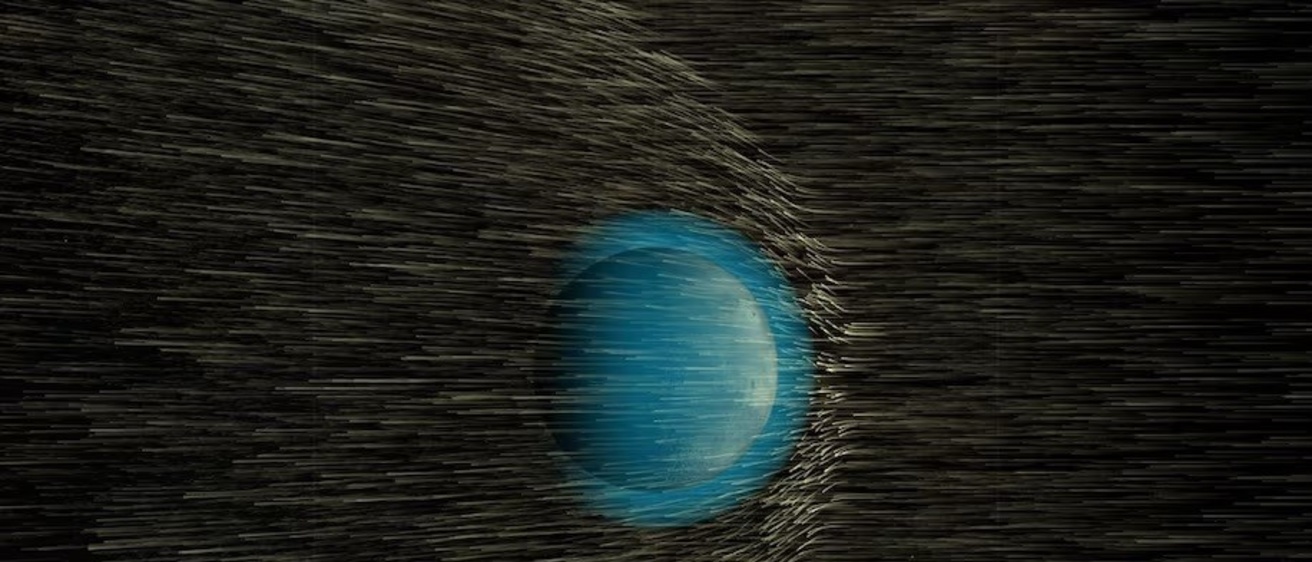The sun constantly spews gas and particles charged with electricity into space at a million miles per hour. The stream, known as the solar wind, helps ward off rays that are harmful to Earth and can help create the northern lights on planets.
One day last December, it disappeared as it approached both our planet and Mars. In response to the sudden lull in the solar wind, the protective magnetic layer surrounding each planet unexpectedly expanded, according to scientists and a recent study published in the Journal of Geophysical Research: Space Physics.
The disruptions to the Martian magnetosphere caused by changes in solar wind could help paint a fuller picture on how the planet lost its water billions of years ago, the study’s authors say. On Earth, scientists say understanding lulls in the solar wind are important because they can cause interference with satellites and communications.
The solar wind’s effect on Mars
Around 4 billion years ago, oceans, rivers and lakes supposedly covered Mars. Over time, the liquid water disappeared from the surface. Scientists are interested in studying variations in the solar wind around Mars because it could lay out the various scenarios that led to water loss.
So far, the scientists know how strong solar winds affect the Martian atmosphere. Billions of years ago, the relentless stream of solar particles and ultraviolet light may have stripped its atmosphere. The weakening magnetic field could have allowed more ions on the planet to escape into space — including water.
“For water to be in stable liquid form, you have to have enough atmospheric pressure pushing down on it,” Shannon Curry, co-author and planetary physicist at the University of California at Berkeley, said in a news conference. When the atmosphere on Mars eroded, “the atmospheric pressure lifted, and then the water started evaporating and being lost to space that way.”
For nearly 10 years, NASA’s Mars Atmosphere and Volatile Evolution (MAVEN) has watched Mars and informed how solar particles eroded the Martian atmosphere and its now absent liquid water. Scientists learned most ions were lost to space and during intense solar wind episodes.
But they didn’t have observations for when the solar wind was nearly absent around Mars — until now.
Around Dec. 26, the MAVEN spacecraft observed something unusual. The density of the solar wind around Mars dropped by a factor of 100, as described in the new study. Mars’s magnetosphere tripled in size by thousands of kilometers without the pressure of the solar wind compressing it.
A collision between two different solar winds turned the dial down, said Jasper Halekas, lead author and space physicist at the University of Iowa. A fast solar wind acted like a snow shovel, pushing a weaker, slower solar wind and clearing the space behind it.
The Martian atmosphere returned to its normal size the next day. Halekas said other low-density solar wind events occurred around Mars since then, but this was the longest and most dramatic. But how do these same events affect our lively Earth?
Disruptions on Earth
On its way to Mars in December 2022, the solar wind vacuum hit Earth.
As the solar wind decreased around our planet, Halekas said another NASA mission observed the expansion of the Earth’s magnetosphere. Shock waves around Earth, known as a bow shock, doubled, he said, although the number was not included in the new study.
But this wasn’t the first, or most dramatic, solar wind disappearance around Earth. In 1999, another lull caused the bow shock around Earth to at least quadruple.
In fact, one group of researchers found almost 12 low-density solar wind events around Earth from 1995 to 2017, but more could have gone undetected. Radio astronomer Janardhan Padmanabhan, who helped study past events, said they will analyze the Dec. 22 event, too.
“The whole Earth was engulfed in this huge low-density bubble, slow-moving bubble” during these events, said Padmanabhan, a senior scientist at the Indian National Science Academy.
Scientists are mostly interested when solar winds headed toward Earth are stronger than normal. Solar particles can collide with our protective magnetic shield and can cause different effects from the northern lights to radio blackouts to interruptions in satellite operations.
But Earth could experience similar effects with low-density solar wind, too, said Ryan Dewey, a space physicist at the University of Michigan not involved in the study.
During a low-density solar wind event, he said nearly everything in Earth’s magnetosphere expands — including its radiation belts, which are made up of billions of high-energy particles and help protect Earth against harmful energy. If those radiation belts move over communications or GPS satellites, for example, the influx of particles could be hazardous for spacecraft.
“They do affect radio wave propagation in the Earth’s atmosphere, and therefore disrupt communications,” said Allison Jaynes, a space and plasma physicist at the University of Iowa not involved in the study.
Reduced solar wind can also cause an unusually intense polar rain — a type of aurora — that was seen in May 1999, Jaynes said. It allows beams of solar particles to travel straight into Earth’s polar region. It’s like when a gridlocked highway suddenly becomes clear.
But there’s a downside to the clear speedway for satellite operators. The precipitation of particles, depending on their volume, can heat the upper atmosphere, Dewey said.
That heat could cause the atmosphere to expand outward and cause satellites to drag.
The low traffic could also pave the way for a bigger solar danger toward Earth, Padmanabhan said. If a large eruption on the sun, known as a coronal mass ejection, follows behind, it could rock Earth’s radio, rail and electric systems and satellite communications.
If such a coronal mass ejection was headed toward Earth during a solar wind disappearance event, “you cannot imagine what havoc it could do,” Padmanabhan said.
by Kasha Patel, Washington Post
(Subscription required to view the article online.)
